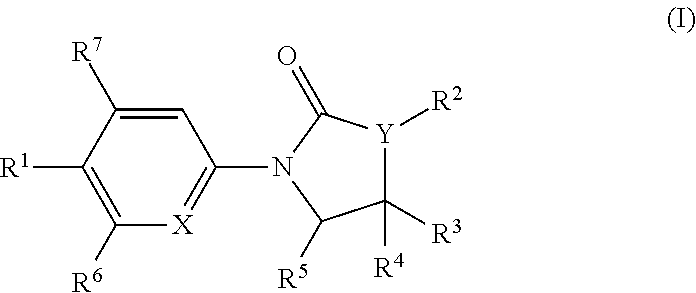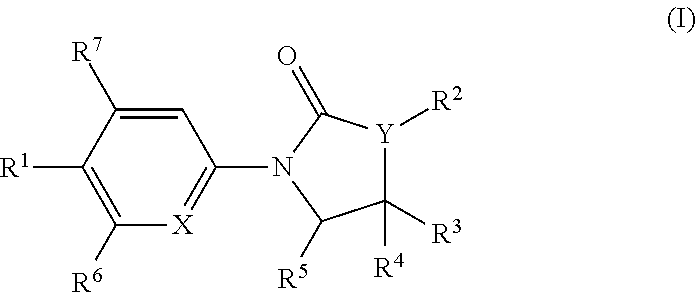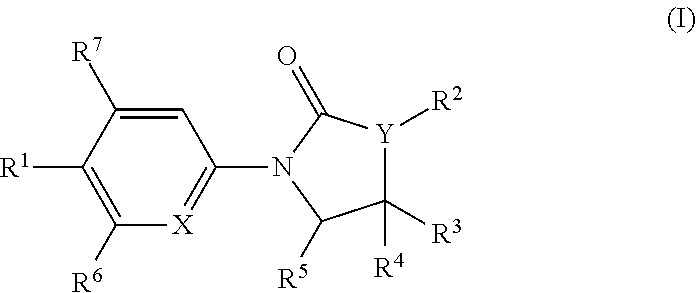Chemical Compounds
a technology of imidazolidinone and substituted pyrrolidinone, which is applied in the field of substituted pyrrolidinone and imidazolidinone derivatives, can solve the problems of cell death, inability to synthesize vital proteins, and inability to regulate er redox homeostasis
- Summary
- Abstract
- Description
- Claims
- Application Information
AI Technical Summary
Benefits of technology
Problems solved by technology
Method used
Image
Examples
examples
[0897]The following examples illustrate the invention. These examples are not intended to limit the scope of the present invention, but rather to provide guidance to the skilled artisan to prepare and use the compounds, compositions, and methods of the present invention. While particular embodiments of the present invention are described, the skilled artisan will appreciate that various changes and modifications can be made without departing from the spirit and scope of the invention.
examples 1 to 3
1-(4-(4-amino-7-methyl-7H-pyrrolo[2,3-d]pyrimidin-5-yl)-3-fluorophenyl)-4-(2,5-difluorophenyl)-3-ethylimidazolidin-2-one and enantiomers
[0898]
Step 1
[0899]To a stirred solution of 2,5-difluorobenzaldehyde (20.0 g, 140.74 mmol, 1 equiv), malonic acid (17.56 g, 170.0 mmol, 1.2 equiv) and ammonium acetate (21.7 g, 282.0 mmol, 2 equiv) in EtOH (250 mL) was heated at 80° C. for 16 h. After completion of starting material the reaction mixture was cooled to room temperature, the solid obtained was filtered and washed with n-pentane and dried to give the 3-amino-3-(2,5-difluorophenyl)propanoic acid as off white solid (16.0 g, 56.0%). LC-MS (ES) m / z=202.0 [M+H]+. 1H NMR (400 MHz, DMSO-d6) δ ppm 2.40-2.42 (m, 2H), 4.40 (t, J=6.0 Hz, 1H), 5.6-6.8 (br. s, 2H), 7.07-7.12 (m, 1H), 7.13-7.21 (m, 1H), 7.34-7.39 (m, 1H).
Step 2
[0900]To a stirred solution of 3-amino-3-(2,5-difluorophenyl)propanoic acid (16.0 g, 80.0 mmol, 1 equiv), in dioxane (150 mL) and sat. NaHCO3 solution (150 mL) was added Boc2O (...
example 4
1-(4-(4-Amino-7-methyl-7H-pyrrolo[2,3-d]pyrimidin-5-yl)-3-fluorophenyl)-4-(3,5-difluorophenyl)pyrrolidin-2-one
[0910]
Step 1
[0911]A stirred solution of potassium tertiary butoxide (2.37 g, 21.12 mmol, 1.2 equiv), in THF (50 mL) was cooled to 0° C., and then methyl 2-(diethoxyphosphoryl)acetate (3.88 mL, 21.12 mmol, 1.2 equiv) was slowly added under argon atmosphere. The reaction mixture was stirred for 30 min at 0° C. 3,5-difluorobenzaldehyde (2.5 g, 17.6 mmol, 1.0 equiv) was added to the reaction mixture drop wise and then ice bath was removed. The reaction mixture was stirred at room temperature for 3 h. After consumption of the starting material, the reaction mixture was quenched with water and extracted with EtOAc (2×50 mL). The organic layer was washed with brine, dried over sodium sulphate, filtered and concentrated to give the (E)-methyl 3-(3,5-difluorophenyl)acrylate as white solid (2.15 g, 61.78% yield). 1H NMR (400 MHz, DMSO-d6) δ ppm 3.72 (s, 2H), 6.78 (d, J=16.4 Hz, 1H), 7...
PUM
 Login to View More
Login to View More Abstract
Description
Claims
Application Information
 Login to View More
Login to View More - R&D
- Intellectual Property
- Life Sciences
- Materials
- Tech Scout
- Unparalleled Data Quality
- Higher Quality Content
- 60% Fewer Hallucinations
Browse by: Latest US Patents, China's latest patents, Technical Efficacy Thesaurus, Application Domain, Technology Topic, Popular Technical Reports.
© 2025 PatSnap. All rights reserved.Legal|Privacy policy|Modern Slavery Act Transparency Statement|Sitemap|About US| Contact US: help@patsnap.com



